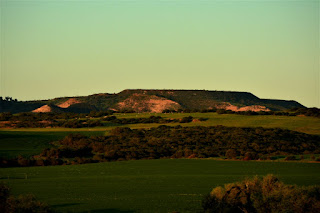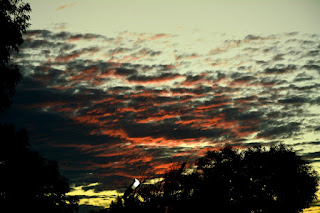Good Morning Geraldton!
Low 11°c (52°F) – High 20°c
(68°F)
Having survived the outing yesterday and the ankle not giving much pain
at all, just a little swelling, we decided to backtrack to see what we’d missed
having made a bee-line for Geraldton with Kitty having a moment. Originally we were going to head to
Northampton to take photos but decided on the way to go further north to the
Pink Lake and Port Gregory. Of course
start time for the trip was delayed due to a certain dog being a little slow to
get going this morning. We’re not
wanting to rush her because we still have a big trip home and want to make sure
we can get her settled with car travel again.
It was a fascinating day of discovering unique little coastal spots
with lots of photo opportunities. Having
spent a lot of time in the van over the past week, it has been nice to be out
seeing the sights and taking photos again.
We didn’t really stop in Northampton at all but worked our way across to
the coast to the Pink Lake near Port Gregory as our first stop. Along the way of course re-encountering the
picturesque countryside we saw on the way in last week that saw us sad to leave
the “outback north”. I guess we’ve come
to terms with that now as we were both able to appreciate the scenes that
appeared over every hill.
The Pink Lake, otherwise known as Hutt Lagoon, is a marine salt lake about
14 km (9 mi) in length parallel with the coast, and around
2.3 km (1.4 mi) wide. It would have been awesome if the vantage point
for the lookout was more elevated. You
really need height to get the full effect of the lake so a drone or flying over
the lake would no doubt be amazing.
There were a couple of guys with a very expensive (huge) drone just
launching it as we were preparing to leave.
Probably should have peeked over their shoulders! It’s
the extremely high level of salinity that gives the lagoon its unusual hue and
its vibrancy changes with the seasons and time of day due to the presence of
the carotenoid-producing algae Dunaliella salina, a source of
β-carotene, a food-colouring agent and source of vitamin A. The lagoon contains
the world's largest microalgae production plant, a 250-hectare (620-acre)
series of artificial ponds used to farm Dunaliella salina.
On to Port Gregory – or Gregory - which at the 2016 census
had a population of 64 in 83 dwellings. Most of the dwellings are holiday
houses and the population fluctuates depending on tourism; with the town at
full capacity during school holidays and throughout the summer. During the
census 50% of dwellings were unoccupied with the national average 11%. Despite the school holidays being over there
was still a good contingent of campers in the camping ground and quite a few of
the houses had vehicles and boats parked nearby.
The area has an interesting history with Port Gregory established in
1849 and named after brothers Augustus and Frank Gregory, two of
Western Australia's most active explorers. In May 1853 sixty convicts
and Pensioner Guards (English military personnel who served on convict
transportation ships) arrived from England via Fremantle and a town site
was gazetted as Pakington near the shore, with Lynton gazetted around the same
time as the convict depot and town site for the guards. The convicts were
used for Government works and in establishing a road to the Murchison
River and the Geraldine lead Mine, operated from 1849 to 1875.
Ticket-of-leave men from the depot were hired out for work at the port and on
nearby farms and stations from the Convict Hiring Station at Lynton. The remains of these buildings are on display
to visit.
A major employer was Captain William Ayshford Sanford who, as magistrate for the region and the Superintendent of Convicts, built an impressive homestead alongside Lynton. He resigned in 1854 and took up pastoral and whaling pursuits, establishing a whaling facility just north of the Pakington town site. The name Pakington was rarely used however and the name Port Gregory, the harbour located next to the town, was more generally accepted. Initially the port was used by whalers and pastoralists and to ship lead ore and pig lead from the mines and salt from nearby Hutt Lagoon was shipped until the depression when the port and both the 'towns' became deserted.
On 27 January 1943 the Japanese submarine I-165, while planning to
bombard the nearby port of Geraldton, observed three aircraft and what was
believed to be a destroyer and aborted the attack. On the following night the submarine bombarded
Port Gregory with about ten 100-mm (3.9-inch) shells from her deck gun, in the
belief that a crayfish cannery was an ammunition factory. There was no damage
and Port Gregory was at the time deserted. Naval authorities only learned of
the attack when the submarine's battle report radio signal was intercepted and
decoded a week later. There are many
shipwrecks in the vicinity, most caused by the unsuitability of the port for
large vessels. The town changed its name to Gregory in 1967.
The nearby Lynton Homestead is of very high historic, social and
aesthetic significance to the district and the State because of its
associations with the convict hiring depot, the links with the Port Gregory
area and the commanding setting and construction of its buildings. Known variously as Sanford's House, the
Lynton Homestead and the Governor's Residence, Captain Sanford had the elegant,
two-storeyed house built for himself in 1853. The date is carved into the
keystone above the main doorway.
Anna Harriette Leonowens lived in Lynton during the mid-1850s, while
her husband, Thomas Leonowens, worked there for the Commissariat. Anna became well known with the publication
of her memoirs, beginning with The English Governess at the Siamese Court (1870),
which chronicled her experiences in Siam (modern Thailand), as
teacher to the children of the Siamese King Mongkut. Her own account was fictionalised in Margaret
Landon's best-selling novel Anna and the King of Siam (1944), as well
as adaptations for other media such as Rodgers and Hammerstein's 1951
musical “The King and I”.
I wondered if it has always been windy in this area as the number of
trees that are leaning at a 45 degree angle or more are amazing.
Keeping to the coast road we drove further south to a little town
called Horrocks stretching along a 7km section of WA’s Coral Coast. In the 2016 census Horrocks had a
population of 138 people in 184 dwellings – 63 of which were occupied with 62%
of dwellings unoccupied. Again, most of the dwellings are holiday houses and the
population fluctuates depending on tourism. Most of the houses along the
foreshore area truly are just beach shacks here but many with some unique
decorations and reminding us a little of the Brighton Bathing Boxes. The town was named after Joseph Lucas
Horrocks, a convict who was transported to Western Australia in 1851
for forging and uttering (knowingly selling forged documents).
Horrocks received a conditional pardoned in 1856 and built a non-denominational
(and first) church in Northampton.
Due to our detours, by the time we got back to Northampton it was
almost sunset so we headed for home and will hopefully return to Northampton
before we leave the area – light willing.
We made one last detour off the highway to Coronation Beach which is
basically a beachfront camping area which has no power or water, but what a
great little stopover it would be. It
ticked the boxes for us as well for a couple of “almost sunset” shots before
heading home.
It was after 6.00pm by the time we got back to the park and once again
there were lots of new arrivals camped up for the night. We are clearly in a tight site as two motor homes
(rentals) pulled in well after 7.00pm and in the course of one of them backing
on to their site, next thing we heard the puppy pen get moved by the back of
their MH as they almost reversed over it and the white post it was beside
marking the edge of the site. Thank
heaven we didn’t have the awning out as it would have definitely been history.
A major employer was Captain William Ayshford Sanford who, as magistrate for the region and the Superintendent of Convicts, built an impressive homestead alongside Lynton. He resigned in 1854 and took up pastoral and whaling pursuits, establishing a whaling facility just north of the Pakington town site. The name Pakington was rarely used however and the name Port Gregory, the harbour located next to the town, was more generally accepted. Initially the port was used by whalers and pastoralists and to ship lead ore and pig lead from the mines and salt from nearby Hutt Lagoon was shipped until the depression when the port and both the 'towns' became deserted.
























.JPG)
.JPG)







































No comments:
Post a Comment